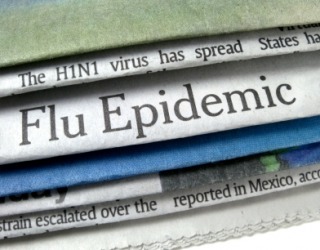Fast Access to Records Helps Fight Epidemics
Public health departments around the country have long scrutinized data from local hospitals for indications that diseases like influenza, tuberculosis, AIDS, syphilis and asthma might be on the rise, and to monitor the health consequences of heat waves, frigid weather or other natural phenomena. In the years since 9/11, this scrutiny has come to include signs of possible bioterrorism.
When medical records were maintained mainly on paper, it could take weeks to find out that an infection was becoming more common or that tainted greens had appeared on grocery shelves. But the growing prevalence of electronic medical records has had an unexpected benefit: By combing through the data now received almost continuously from hospitals and other medical facilities, some health departments are spotting and combating outbreaks with unprecedented speed.
More than one-third of the nation’s 5,000 acute care hospitals now use electronic medical records, and the share of primary care doctors using them has doubled to 40 percent in the last two years, said Dr. Farzad Mostashari, the Obama administration’s national coordinator for health information technology.
The technology’s spread is helping “officials faced with events of public health significance to know sooner, act faster and manage better,” said Dr. Seth Foldy, a senior adviser to the Centers for Disease Control and Prevention.
In February, public health officials in Michigan noted an increase in electronic reports from clinical laboratories indicating E. coli cases in several counties. Eleven patients were identified, including six who were hospitalized.
In less than a week, officials had enough evidence to warn the public that the infection appeared to be linked to clover sprouts in food at the Jimmy John’s sandwich chain, said James Collins, director of the communicable diseases division at the state’s Department of Community Health. The chain quickly removed the sprouts, and by April, the 11-state outbreak was over.
“You can see it happen in real time and zero in on the cause faster,” said David A. Ross, director of the Public Health Informatics Institute, a nonprofit organization that helps write digital standards. “That can save both lives and money.”
 In Massachusetts, the data are being used to prevent hepatitis infections. Medical labs transmit more than 100,000 electronic reports annually to the state health department. Names are confidential, though available to certain medical personnel. The agency’s software sorts through the reports and every year identifies more than 1,500 cases of hepatitis B for follow-up.
In Massachusetts, the data are being used to prevent hepatitis infections. Medical labs transmit more than 100,000 electronic reports annually to the state health department. Names are confidential, though available to certain medical personnel. The agency’s software sorts through the reports and every year identifies more than 1,500 cases of hepatitis B for follow-up.
Infected women ages 14 to 44 get special attention. Health officials alert their medical providers to infections; they in turn identify anyone who is pregnant or recently gave birth. Their newborns are vaccinated and then monitored.
Without that prompt protection, those babies risk lifelong infection with hepatitis B and its consequences, liver disease, cirrhosis and cancer. With paper records, locating at-risk babies would take weeks or months, said Kevin Cranston, director of the infectious disease bureau at the Massachusetts Department of Public Health.
“That would be too late to be of benefit to the newborn,” he said. Although the C.D.C. recommends prompt hepatitis B vaccination for all newborns, nationally, four in 10 did not get that protection, according to an agency report last year.
When the H1N1 flu pandemic broke out in 2009, Wisconsin laboratories generated thousands of positive H1N1 test results, said Dr. Foldy, who was then chief medical officer of the Wisconsin Health Information Exchange.
“We were able to route this electronically into our case management system to alert public health nurses,” Dr. Foldy said.
“Because we were getting near real-time information from hospitals, we could see that even with the large numbers of emergency room visits for flulike symptoms, very few were being admitted as inpatients,” he added. This provided an early glimpse of how the pandemic was rising and then declining.
Public health officials in Marion County, Ind., were among the first to sound the all-clear in the flu outbreak by tracking the drop in cases from electronic reports from hospitals and laboratories, forwarded by the Indiana Health Information Exchange.
 More than 150 health information exchanges are now operating or being set up across the country. (These differ from the insurance exchanges mandated under the Affordable Care Act.) Each exchange receives electronic medical data from clinical laboratories, hospital admissions offices and emergency rooms and relays it to relevant public health agencies.
More than 150 health information exchanges are now operating or being set up across the country. (These differ from the insurance exchanges mandated under the Affordable Care Act.) Each exchange receives electronic medical data from clinical laboratories, hospital admissions offices and emergency rooms and relays it to relevant public health agencies.
Health care providers are required to provide pertinent data electronically to local and state public health officials, who feed into a national digital network coordinated by the C.D.C. in Atlanta.
Using an electronic records registry, the Urban Health Plan, a network of clinics in the South Bronx and Queens, was able to triple its caseload of mostly young, low-income asthma patients to 8,100. “We are in the heart of asthma country,” said Dr. Samuel De Leon, a lung specialist who is Urban Health’s chief medical officer.
His group compared spending per patient with a Medicaid managed care plan in the city that did not then have electronic monitoring. Using its record system to keep tabs on its patients, Dr. De Leon said, Urban Health was able to reduce emergency room visits and hospital admissions.
“For children, we saved about 39 percent of the cost of care. For adults, savings were in the 25 percent range,” he said.
New York City health officials began using electronic medical records six years ago. After reviewing the incoming medical data, city health department officials recently discovered that smoking rates are a little higher in Staten Island than in the other boroughs.
Now, instead of sending trainers on routine visits to every primary care doctor to help them learn to use electronic records to improve care, the visits are concentrated to help those physicians whose patients need it most.
“We can identify and monitor trends in high-priority diseases and health problems by geography and groups,” said Dr. Amanda Parsons, a deputy commissioner at the city’s Department of Health and Mental Hygiene. “We can tell where things are improving or getting worse.”
Source: www.nytimes.com; Milt Freudenheim; June 18, 2012.




Leave a Reply
Want to join the discussion?Feel free to contribute!